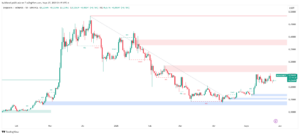
- SUI has held steady above the key $3.50 support level following the $223 million Cetus DEX hack, with network metrics and derivatives data signaling a potential recovery.
- Meanwhile, the incident has reignited debate over Proof-of-Stake governance and decentralization, as experts question the practical limits of minority-led forks in insider-heavy ecosystems.
SUI is showing signs of recovery after suffering a brutal blow that cost Cetus Protocol $223 million during a hack. Currently surged 0.80% which saw the asset trade with $2.32.
This price action comes as the network navigates both a technical recovery and a philosophical debate about the limits of Proof-of-Stake (PoS) systems.
The immediate fallout of the Cetus hack saw SUI drop nearly 8%, triggering a bearish engulfing pattern. However, a long-tailed Doji candle formed over the weekend signaled strong buy pressure at lower levels.
If SUI maintains this support, the next upside target is the previous support-turned-resistance at $4.07. Yet, momentum indicators such as the RSI and MACD reflect caution, hinting that a breakdown below $3.50 could open the door to a retest of the 200-day EMA at $3.01.
Despite the volatile price movement, the Sui ecosystem is showing signs of recovery. The Total Value Locked (TVL) on Sui dropped sharply from $2.13 billion to $1.54 billion post-hack but has since rebounded to $1.68 billion.
Stablecoin market cap remains above $1 billion, and DEX volumes have recovered, reaching $271.9 million.
SUI’s derivatives market also paints a cautiously optimistic picture. Open Interest rose to $1.77 billion, and the funding rate climbed to 0.0124%, reflecting increased bullish intent. Short liquidations also outpaced longs, signaling growing investor confidence in a price rebound.
However, beyond the charts lies a deeper discussion about decentralization and governance. The Sui network’s ability to freeze $162 million of stolen funds sparked praise from many but also triggered debate on the real-world practicalities of PoS networks.
Monad’s James Hunsaker questioned the feasibility of forking PoS chains, citing concentrated insider stakes that often overpower minority voices. Solana’s Anatoly Yakovenko countered, emphasizing user demand and coordination as the true source of decentralized power.
Note that in a PoS blockchain, “minority” and “majority” here are defined in terms of stake.
In most chains, stake is highly concentrated amongst a small group of insiders.
While you could fork as minority, no one will care unless you are somehow successful at social shaming.… https://t.co/FvlmMutpOP
— James (@_jhunsaker) May 25, 2025

The rapid response by Sui validators has become a litmus test for how modern blockchains balance user security with decentralization. While some celebrate the intervention as a model for safeguarding user assets, others argue it highlights the inherent centralization risk in PoS systems where validator control may supersede protocol neutrality.

Still, the event has largely reinforced confidence in Sui’s infrastructure. The collaborative recovery effort between the Cetus team, Sui Foundation, and cybersecurity experts—including a whitehat settlement offer, has been viewed as a textbook incident response.
As the community watches closely, Sui’s performance in both markets and ideology may well shape future standards for how Web3 platforms respond to crises, balancing price, participation, and principle.
The post Experts Weigh In: SUI’s Post-Hack Price Gains vs. Proof-of-Stake Practical Limits appeared first on ETHNews.

